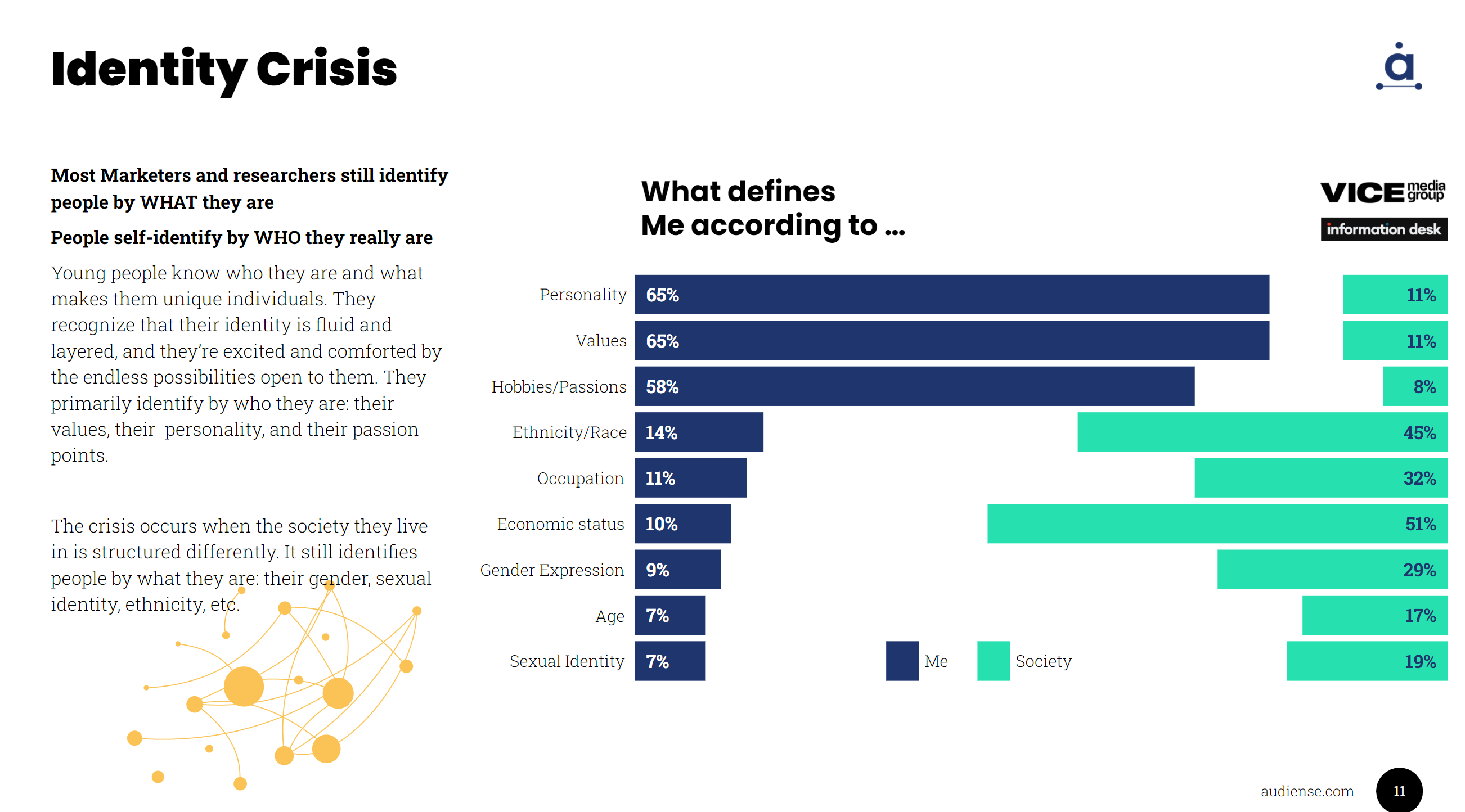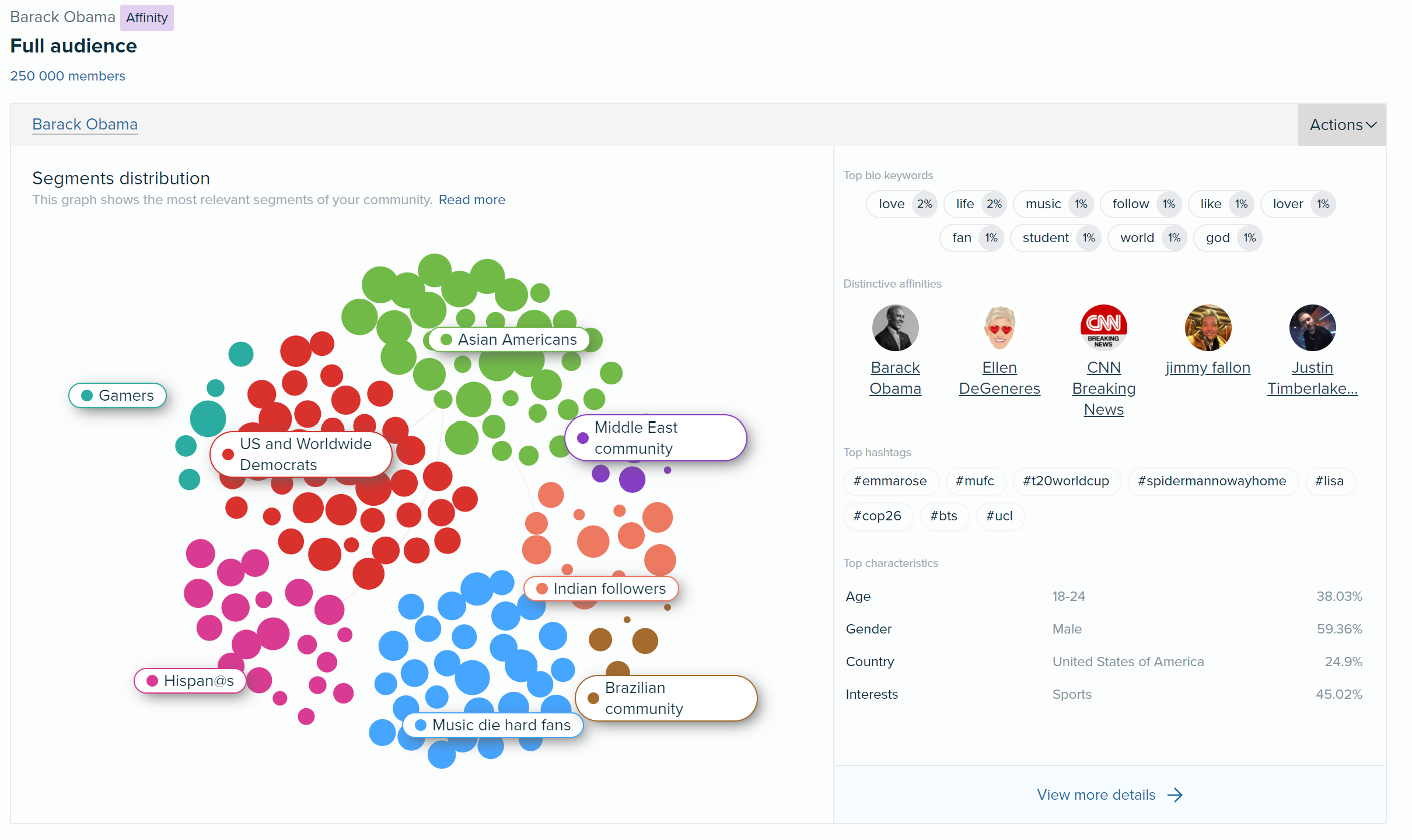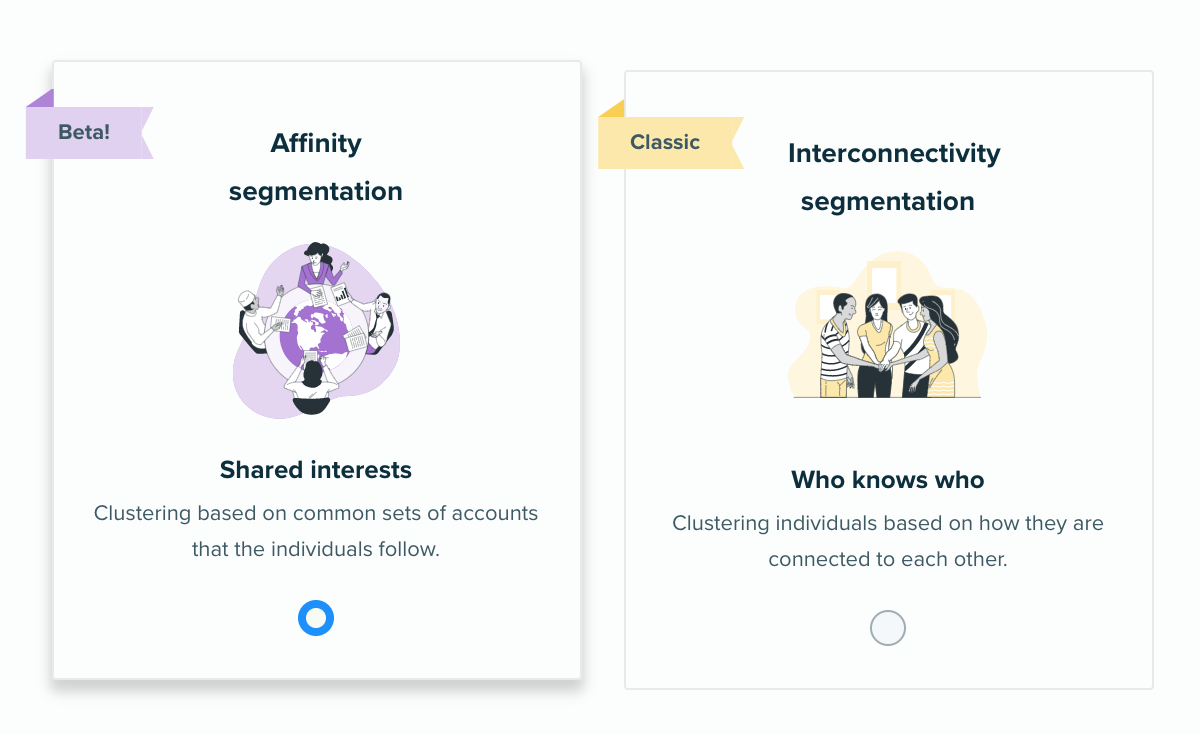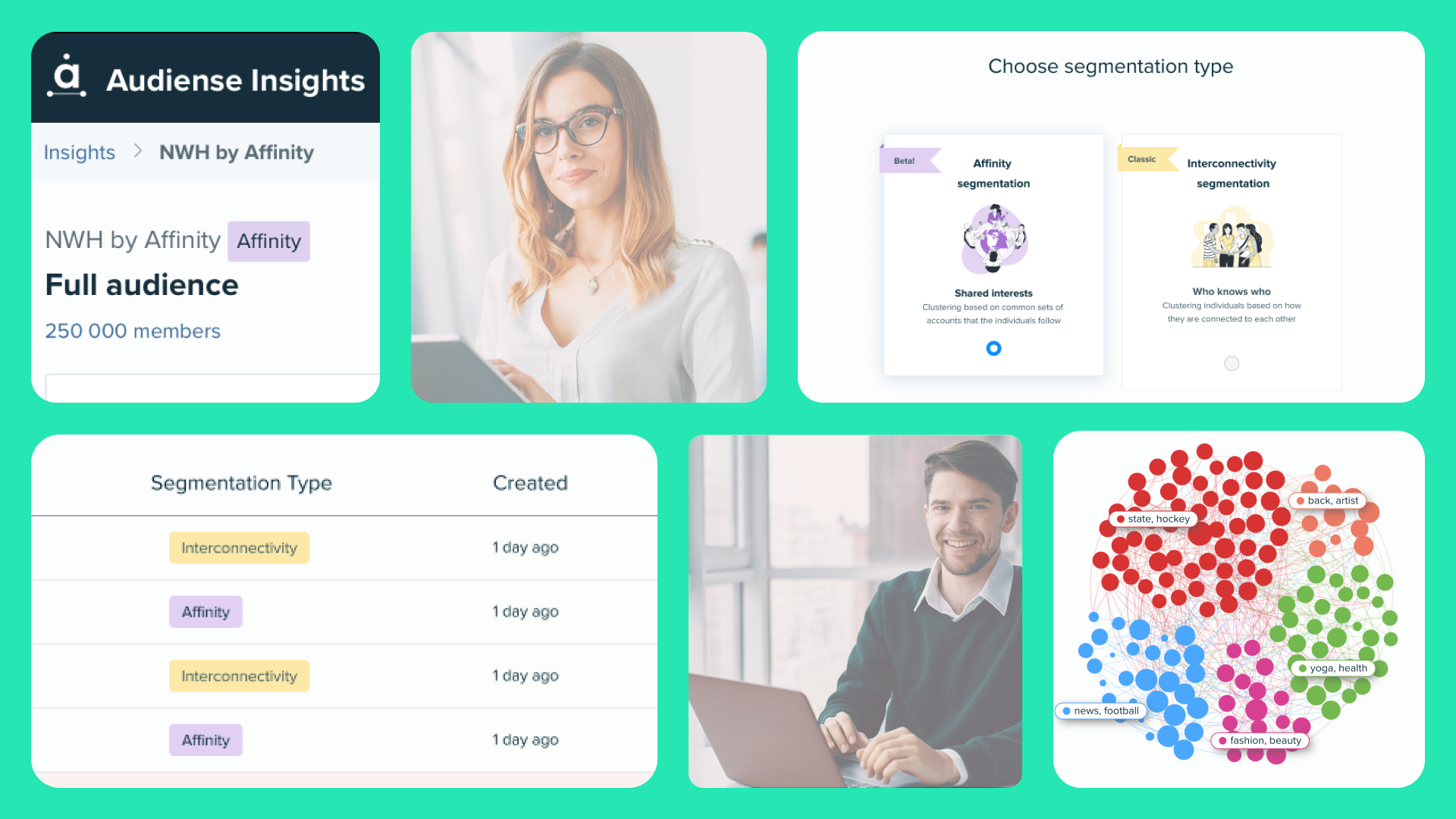[PRODUCT UPDATE] Affinity segmentation is now available!
Affinity segmentation is here! We are so excited to share this launch with you. For Audiense, we want to be pushing the boundaries of innovation and reflect the scope of possibility within our industry. With the feedback our users have provided, we want to offer different alternatives to cover their different methodologies and use-cases. Let us introduce you to the new level of value it will bring to your role, how to select it in Audiense, and our recommended use-cases to go with it.
First of all, I’m going to give a big clap for our teams that made this happen (it’s actually every team at Audiense, but particularly our product and engineering teams) woohoo!
Now, let me explain the difference between our two segmentation methods...
Affinity segmentation is based on commonalities of affinity, simply put: following-behaviour. In practice, Audiense will look into all of the accounts that your defined audience is following, from here, the algorithm groups the audience members into segments based on common sets of accounts the individuals are following, which enables us to infer their interests.
Interconnectivity, our classic and familiar segmentation method, is still available. This method involves Audiense creating segments by clustering individuals based on how they are interconnected, simply plut: “who knows who”. We take into account any reciprocal followings, then cluster them together, for example, if person A follows person B, then they’ll be clustered together. This method creates consistent, relevant segments, whilst identifying unique characteristics for each segment. Then, we can ask “how do they know each other”, such as what are the hidden trends that the platform has revealed, including interests, psychographics, influencers.

The difference between segmentation and filtering is that segmentation is an output that happens when an audience is grouped together by unique characteristics and connections that are data-driven and unbiased. Whereas, filtering is often an input method used as an initial step to define an audience, or as a step to select an audience post-insights, the results of which will provide a predetermined audience. You can read more about our segmentation methods in our user-guide HERE.
When it comes to using segmentation, you don’t even have to get the initial definition perfect because the segmentation will highlight to you how the audience defines themselves. (This is key to helping you inform your next report). Here are two examples:
- To identify streamers or Twitch users, you define your audience by followers of @Battlefield. Whilst the initial audience was too broad, the segmentation delivers segments of the audience you were looking to find.
- You have a small number of users engaging with the hashtag of a B2B conference, the segmentation will break the audience into segments such as tech providers, brands and agencies, and others that you were initially seeking.
We have some recommendations when it comes to choosing a segmentation method in Audiense.
We suggest Affinity segmentation if you are:
- Analysing large audiences, and wanting to understand broadly defined segments. For example, a global B2C audience.
- Looking for fewer segments, but with more encompassing definitions that provide a higher-level segmentation - this may be helpful for businesses with limited resources to activate media buying
- When you need the segment sizes to add up to the total audience size of the report.
- Understanding audiences through the lens of one interest/affinity, but that might also have overlapping interests and traits in other areas
We suggest Interconnectivity segmentation if you are:
- Looking for niche segments. This could be a new community that has developed in your audience that you haven’t considered before. It could be a community that represents an area of specialised interest. These are perfect for a really targeted approach.
- Identifying ‘odd’ segments. These could be non-desired segments within your audience, such as bots (they tend to not be interconnected, and therefore will stand outside of your segments), or spam followers (such as follow4follow accounts, or giveaway vultures).
- B2C and B2B work well here. In B2B, groups can be interconnected without explicitly expressing their job role. For example, if we looked at Facebook employees, the segmentation would cluster the audience into departments such as engineers/product, and sales/reps, without the members having publicly declared that data. We believe that B2B cases can find Interconnectivity segmentation particularly valuable in breaking down their markets into beachheads to conquer.
- Identifying audiences with a fairly high level of being like-minded (and therefore, likely to be influenced by similar messaging)
Let’s take a look at some real examples. We ran a report on followers of @BarackObama (and edited the segment names). For the purpose of this report, we stuck with the 250 000 sample, as we didn’t feel the need to expand the audience. In this case, there is still a fair amount of location-based influence in these segments. However, when we take a closer look into who influences them, their interests, and the content they’re engaging with online, that’s when we say their hobbies and passions come to the surface. We can see broad interests such as Music, Gaming, Politics (particularly Democrats) are mixed into these segments. This represents the new world today - influenced by our location and habitat, but also our passions drive us and bring us into online communities that are thriving on social media.

In a different Affinity report, based on followers of @Lululemon (with auto-generated segment names), we see sport disciplines (such as hockey, football, yoga) and lifestyle (such as fashion and art) to be the main focuses. When it comes to targeting this audience, we can see clear distinctions and different routes to take. To compare to an Interconnectivity report, the followers of @PeanutButterCo include smaller segments (based on percentage of full audience) and provide a deeper level of niche audiences. This can be useful for exploring new avenues to expand smaller, but still important, audience segments.
During out testing phases, a selection of users have helped us with their feedback, and here’s what they have to say:
 "Whilst Audiense’ interconnectivity segmentation is great for understanding the signals that pull users apart, the new affinity segmentation enables us to hone in on the traits that unify consumers. This is particularly useful when considering how to activate our audiences across social channels as we can identify opportunities for both reach and precision across segments." Victoria Hoyle, Research Manager // Pulsar
"Whilst Audiense’ interconnectivity segmentation is great for understanding the signals that pull users apart, the new affinity segmentation enables us to hone in on the traits that unify consumers. This is particularly useful when considering how to activate our audiences across social channels as we can identify opportunities for both reach and precision across segments." Victoria Hoyle, Research Manager // Pulsar
 "The affinity segmentation has given us a valuable new lens through which to develop greater depth of insight and understanding of key audiences' behaviour. Understanding the things that really join people outside the category in which we're operating is paramount." Oliver Lewis, Insights Director // Convosphere
"The affinity segmentation has given us a valuable new lens through which to develop greater depth of insight and understanding of key audiences' behaviour. Understanding the things that really join people outside the category in which we're operating is paramount." Oliver Lewis, Insights Director // Convosphere
Ready to try it for yourself?
When creating your Insights report, continue with the first two steps (choose & define audience type).
At the third step, you will now see two options to choose from to select segmentation. One is our classic Interconnectivity, and one is our new Affinity.

Once chosen, continue to step 4 to launch your report. You will be able to identify report types by their label in your Insights dashboard.
Our Affinity segmentation is still in a Beta stage, and available to all our paid Insight users. Therefore, if you have any feedback on this new feature, please send it to product@audiense.com.
As a note, affinity segmentation reports will still count towards your monthly report credit in the same way that current interconnectivity reports do. Even if you created two reports with the same audience definition but each with a different segmentation method, it will still count as two reports. If you have any questions, please contact your Account Manager.






